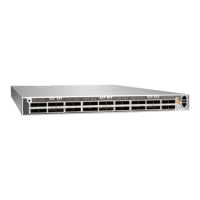hierarchy level and commit the conguraon. The network port is reset to the default Ethernet
interface.
Port Numbering
The interfaces for the PTX10001-36MR are divided into logical PICs and physical opcal ports as
follows:
• PICs: There are three logical PICs, numbered 0, 1, and 2 from le to right.
• Ports: Each PIC controls 8 QSFP56-DD ports, numbered 0 through 3 and 8 through 11 from le to
right. Each PIC also controls 4 QSFP28 ports numbered 4 through 7 from le to right.
Each PIC uses the same port numbering.
Figure 4 on page 12 shows how the PTX10001-36MR network ports are divided into the 3 PICs.
Figure 4: PTX10001-36MR PIC Locaons
How to Congure the QSFP28 Ports for 10-Gbps, 25-Gbps, and 40-Gbps Speeds
The QSFP28 ports support 10-Gbps, 25-Gbps, 40-Gbps, and 100-Gbps speeds. 100-Gbps is supported
on all QSFP28 ports. 10-Gbps, 25-Gbps, and 40-Gbps speeds are not supported on all QSFP28 ports.
Table 4 on page 13 lists the supported ports.
Further, when these supported QSFP28 ports are conguring for 10-Gbps, 25-Gbps, or 40-Gbps speeds,
there are corresponding QSFP28 ports that must be powered o. Table 4 on page 13 lists the ports
that must be powered o.
You must congure these ports o manually through the CLI. The PTX10001-36MR does not
automacally power o the ports.
12

